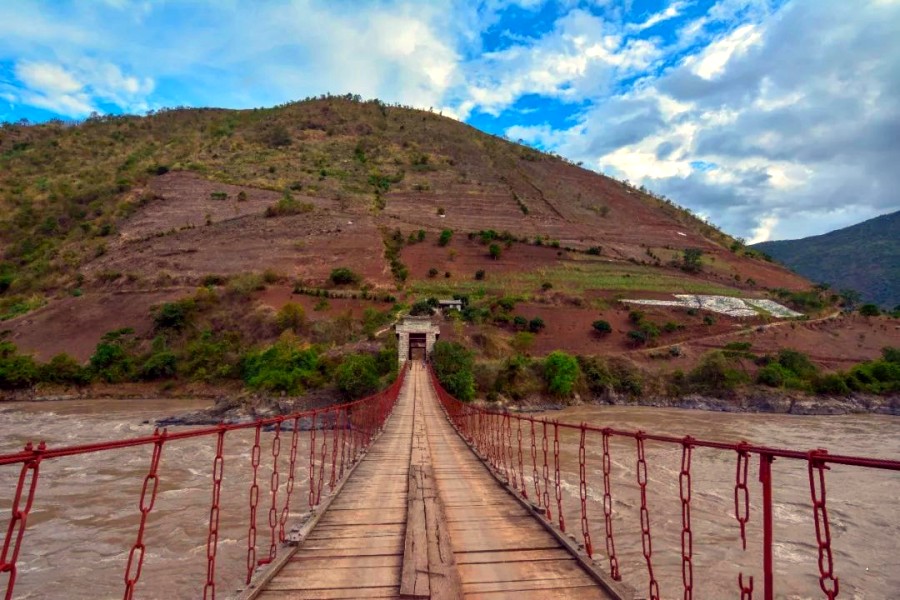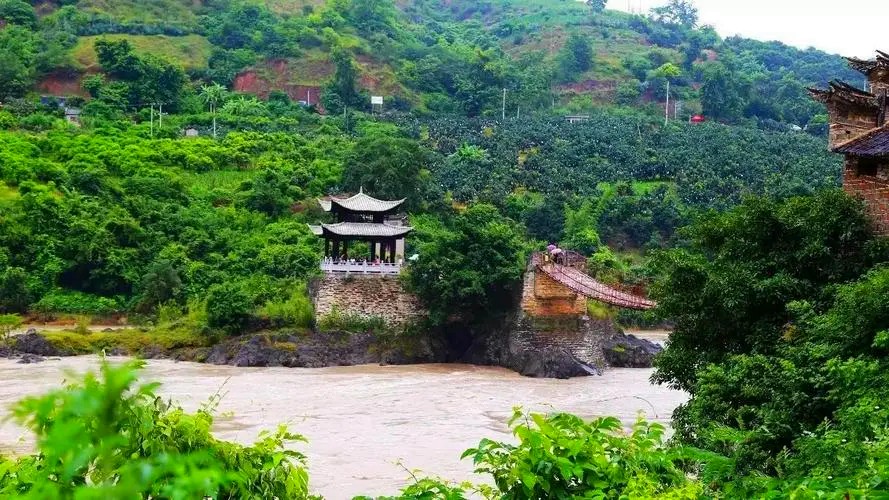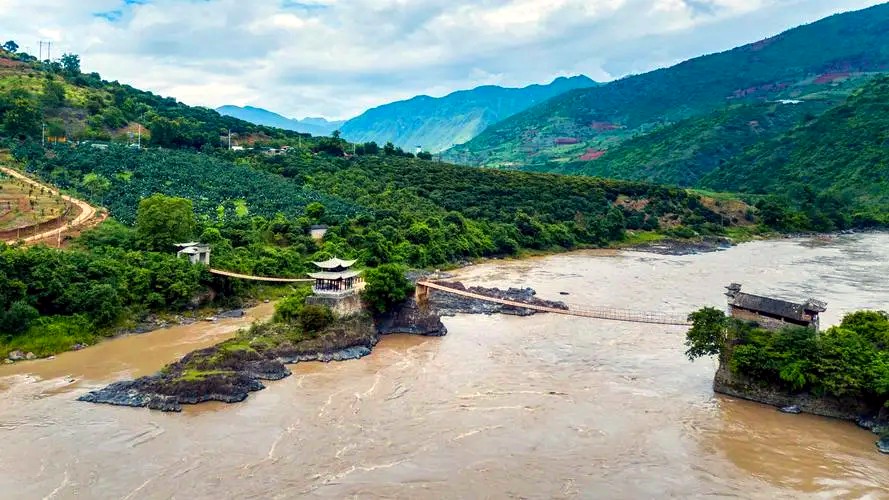
Shuanghong Iron Bridge in Baoshan City
Chinese Name:保山市芒宽双虹桥
English Name: Shuanghong Iron Bridge in Baoshan City
The Shuanghong Iron Bridge (双虹桥), located in Mangkuan Township (芒宽乡), Longyang District (隆阳区), Baoshan City (保山市), Yunnan Province (云南省), is a historically significant iron chain suspension bridge that spans the Nu River (怒江). Built in 1789 during the Qianlong Era (乾隆年间) of the Qing Dynasty (清朝), this bridge has served as a key crossing point for both locals and travelers for centuries, offering insight into the region’s rich history and cultural exchanges along the Southwest Silk Road (南方丝绸之路).
The bridge remains a major historical landmark and was declared a provincial cultural relics protection unit in 1993 by the Yunnan Provincial People’s Government (云南省人民政府).
History and Construction
Origins
The Shuanghong Iron Bridge was originally named Feiliang Bridge (飞梁桥) or Feiqiao (飞桥) and was built in 1789 by Chen Xiaosheng (陈孝昇), the prefect of Yongchang (永昌), as part of a larger effort to improve travel and trade across the Nu River. The construction was funded through donations and labor from local residents. It was originally constructed as a wooden suspension bridge but was later upgraded to an iron chain suspension bridge due to its importance as a transportation route.
Reconstruction and Military Significance
In 1859, the bridge was destroyed during a period of military conflict. However, it was rebuilt in 1923, during the Republic of China (民国时期), with significant improvements to its structure. The bridge was further rebuilt in 1933 and again in 1942, when it played an important role during the Second Sino-Japanese War.
In 1942, with the Western Yunnan region facing a Japanese invasion, Chinese forces temporarily removed the bridge’s surface and constructed a military defense post on the eastern bank to block the advancing enemy. The bridge was later repaired in 1944, just in time for the Chinese Expeditionary Force (中国远征军) to use it as a major crossing point during their counteroffensive against Japanese forces in Western Yunnan. This helped secure the Gaoligong Mountain region and led to the eventual defeat of the Japanese in Tengchong (腾冲).

Structure and Design
Physical Dimensions
The Shuanghong Iron Bridge spans a total of 162.5 meters across the Nu River, with a width of 2.8 meters. The bridge is divided into two sections: the east span which crosses the main flow of the river, measuring 67 meters and standing 14 meters above the water; and the west span which crosses a side stream, measuring 38 meters and standing 12 meters above the water.
The bridge is a suspension bridge made of iron chains, with 15 iron chains supporting the east span and 12 iron chains supporting the west span. The structure also includes two stone towers (关楼) at either end and a Wind and Rain Pavilion (风雨亭) in the center, offering shelter to travelers crossing the bridge.
Bridge Design Features
The bridge is designed with a combination of stone and iron. The bridge piers are anchored on island reefs in the middle of the river. These stone piers were specifically chosen for their durability and natural positioning, which allowed for minimal interference with the river’s flow.
The East Tower (东关楼) is made of earth and wood, while the remaining towers and pavilions have been reconstructed after damage over the years.
Cultural Significance
The Name and Legend
The Shuanghong Iron Bridge gets its name from its distinctive appearance, resembling two rainbows arching across the Nu River. According to local legend, when the bridge was first completed, two monkeys from the eastern bank crossed the bridge hand in hand before the official ceremony, thus giving rise to the bridge’s alternate name, Double Monkey Bridge (双猴桥).
A popular legend surrounding the bridge tells the story of its construction. When workers began constructing the bridge’s piers, they mysteriously disappeared each night. The foreman, unable to find a solution, stayed up one night and witnessed an old woman appearing at the construction site. She revealed a more suitable location for building the bridge, and the workers subsequently moved the construction to this new site. Local lore suggests that this woman was the Dragon King (龙王) of the Nu River.

Visitor Information
Location
The Shuanghong Iron Bridge is located at the boundary between Lü Village (鲁村), Yangliu Bai and Yi Ethnic Township (杨柳白族彝族乡) and Tangxi Village (烫习村), Mangkuan Yi and Dai Ethnic Township (芒宽彝族傣族乡), within the Nu River Gorge (怒江大峡谷) of Longyang District, Baoshan City, Yunnan Province. It is positioned at 25°17’13.3″ N and 98°50’55.3″ E, at an elevation of 700 meters.
Accessibility
The bridge is open to visitors year-round and can be accessed via a scenic drive through the Nu River Grand Canyon. The bridge is not only a significant historical site but also offers great photographic opportunities with its stunning landscape and historical architecture.
Opening Hours and Admission
-
Opening Hours: Open all year round.
-
Admission: Free.
Restoration and Preservation
The Shuanghong Iron Bridge has undergone multiple restorations and repairs over the years to preserve its historical and cultural value. In 1988, the bridge was recognized as a city-level cultural relic and in 1993, it was included as a provincial cultural relics protection unit by the Yunnan Provincial People’s Government. The Yunnan Provincial Cultural Heritage Protection Department has set up protection signs around the bridge, and ongoing restoration projects continue to maintain its structure.
Cultural Stories and Poetry
Local Legend
The bridge is surrounded by many local stories, including the tale of the old woman who guided the workers to the perfect construction site. This story has become an integral part of local folklore, further enhancing the cultural significance of the bridge.
Poem: “Early Crossing of Lujiang”
A famous poem from the Republic of China period (民国) by Cun Pinsheng (寸品升), titled “Early Crossing of Lujiang” (早过潞江), references the Shuanghong Iron Bridge and highlights its iconic status:
“The rain has cleared, mist still lingers,
The mighty waves rush under the bridge,
A wild wave rises, as the double rainbow arches,
The red lindens bloom on both riverbanks in autumn.”

Protection and Legacy
The Shuanghong Iron Bridge is one of the largest, most complete iron chain suspension bridges remaining along the Southwest Silk Road. Its strategic location and significance as a symbol of Yunnan’s history and culture have made it an essential part of the region’s heritage.
It is an essential cultural landmark for anyone interested in exploring Yunnan’s history, engineering, and folklore, offering a glimpse into both ancient China’s military significance and its cultural diversity.
The Shuanghong Iron Bridge continues to be a vital link between the communities on both sides of the Nu River and is a living testament to the rich cultural history of southwest China. Whether you’re interested in history, architecture, or natural beauty, visiting the Shuanghong Iron Bridge offers an unforgettable experience in the heart of Yunnan.
Chinese Version: https://www.qqx.com/gonglve/145766992415031296

 7 Days GolfingTour
7 Days GolfingTour
 8 Days Group Tour
8 Days Group Tour
 8 Days Yunnan Tour
8 Days Yunnan Tour
 7 Days Shangri La Hiking
7 Days Shangri La Hiking
 11 Days Yunnan Tour
11 Days Yunnan Tour
 6 Days Yuanyang Terraces
6 Days Yuanyang Terraces
 11 Days Yunnan Tour
11 Days Yunnan Tour
 8 Days South Yunnan
8 Days South Yunnan
 7 Days Tea Tour
7 Days Tea Tour
 8 Days Muslim Tour
8 Days Muslim Tour
 12 Days Self-Driving
12 Days Self-Driving
 4 Days Haba Climbing
4 Days Haba Climbing
 Tiger Leaping Gorge
Tiger Leaping Gorge
 Stone Forest
Stone Forest
 Yunnan-Tibet
Yunnan-Tibet
 Hani Rice Terraces
Hani Rice Terraces
 Kunming
Kunming
 Lijiang
Lijiang
 Shangri-la
Shangri-la
 Dali
Dali
 XishuangBanna
XishuangBanna
 Honghe
Honghe
 Kunming
Kunming
 Lijiang
Lijiang
 Shangri-la
Shangri-la
 Yuanyang Rice Terraces
Yuanyang Rice Terraces
 Nujiang
Nujiang
 XishuangBanna
XishuangBanna
 Spring City Golf
Spring City Golf
 Snow Mountain Golf
Snow Mountain Golf
 Stone Mountain Golf
Stone Mountain Golf















